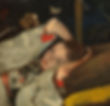Exploring the Beauty of Girl in a White Kimono, 1894, 59 x 55 cm
- Sok Han Teng
- May 1
- 3 min read
Updated: May 2


This painting, created in 1894 by Dutch painter and photographer George Hendrik Breitner, portrays a young girl with Western features, dressed in a Japanese kimono, lying across what appears to be a wooden bed. Now just over 130 years old—an age considered centenarian, the painting has aged, but the girl in a kimono within it remains forever young.
When I saw this painting at the Rijksmuseum in Amsterdam, I was immediately drawn to its color and style. There was something dreamy and mysterious about it that held my gaze. In the museum, most of the artworks I saw depicted European culture—duchesses or princesses in elegant attire posed with grace, or peasants engaged in work or leisure at the pub. This painting felt entirely different. It was a small piece, hanging quietly in the corner of the grand hall, speaking its own language. The girl's stillness and moody gaze offered a rare introspection, contrasting with the exotic beauty of her kimono.

Title: Girl in a White Kimono
Artist: George Hendrik Breitner
Year: 1894
Medium: Oil on canvas
Dimensions: Approx. 59 x 55 cm
Location: Rijksmuseum, Amsterdam
A Glimpse of Japonisme
As one of George Hendrik Breitner’s most celebrated works, Girl in a White Kimono reflects his deep fascination with Japanese culture—a passion shared by many European artists during the late 19th century. This movement, known as Japonisme, flourished in Europe following increased trade with Japan and the influx of Japanese prints, textiles, and design aesthetics.

Breitner collected several Japanese robes and props to stage scenes in his studio. The model for this painting was Geesje Kwak, a 16-year-old housemaid. He painted and photographed her in various kimonos and poses, creating thirteen known works that capture his romanticized vision of the East.
As a skilled photographer, Breitner used photography not just for documentation but as a vital tool in his painting process. He would take reference photos of Geesje to capture fleeting expressions and subtle body language with precision, lending his painted figures a sense of authenticity and naturalism.
Why I Like It
It’s the mood of this painting that draws me in. The colors and contrast are so carefully orchestrated that the entire scene feels suspended in a delicate tranquility. From a distance, it feels dreamy and atmospheric—aligned with the Impressionist style—but as I stepped closer to observe the brushwork, I noticed how confidently the strokes were laid down: loose, fluid, and expressive, more about suggestion than definition. This gives the painting a sense of spontaneity and movement.

Depicting fabric—especially drapery—is never easy. But instead of painting it with strict realism, Breitner used dabs, streaks, and color patches to suggest the play of light on the glossy kimono. The result is a richly textured surface that captures the fabric’s softness and graceful flow. The embroidery or print details on the kimono are merely hinted at with quick, decorative marks, just enough to ignite the viewer’s imagination.

The brushwork on the girl's face is softer and more blended, capturing her delicate features while maintaining an atmospheric distance. It reminded me of the film Memoirs of a Geisha - Western actresses cast in Japanese roles, which sometimes feels jarring or unconvincing. I couldn’t quite resonate with their performances because their gestures and tone of voice were translated into a Western style. However, in this painting, the cultural contrast between Japan and the West feels creative, it looks like an interesting story.
